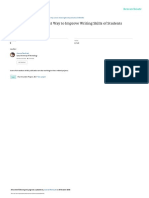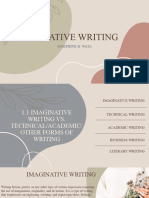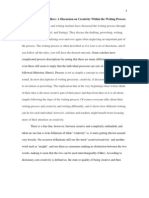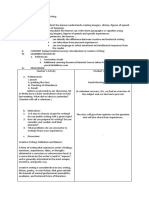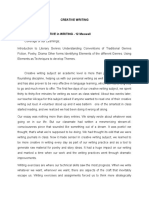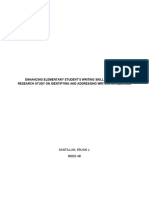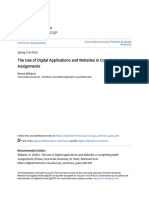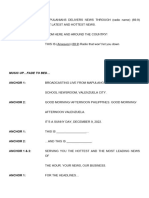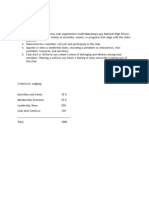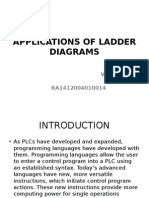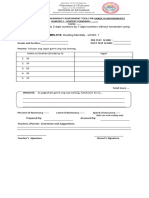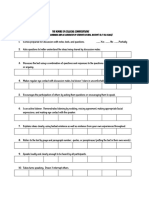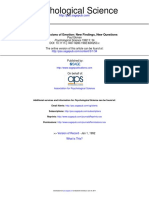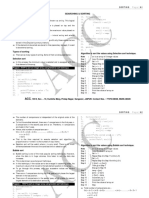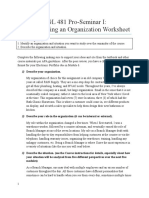EFFECT OF ENGLISH CREATIVE WRITING ON STUDENTS’ ACADEMIC PROGRESS AT GRADUATION
LEVEL PJAEE, 18(10) (2021)
EFFECT OF ENGLISH CREATIVE WRITING ON STUDENTS’
ACADEMIC PROGRESS AT GRADUATION LEVEL
Bakhtawar Nasir1, Dr. Samina Sarwat2, Dr. Muhammad Imran3
1M.Phil. Scholar in English Linguistic, KFUEIT, RYK, Pakistan
2Assistant Professor (HOD of Humanities & Social Sciences), KFUEIT, RYK, Pakistan
3Assistant Professor, Humanities & Social Sciences, KFUEIT, RYK, Pakistan
Bakhtawar Nasir , Dr. Samina Sarwat , Dr. Muhammad Imran , Effect Of English
Creative Writing On Students’ Academic Progress At Graduation Level , Palarch’s
Journal Of Archaeology Of Egypt/Egyptology 18(10), 3347-3357. ISSN 1567-214x.
Key words: Creativity, Creative Writing, Students ‘progress.
ABSTARCT
This study aimed to illustrate the impact of creative writing on students’ progress. The vital
intention of this study is to enrich the ideation of students in writing. As we all realize we all
have varying levels of writing aptitude. However, productive writing must be taught because it is
one of the most problematic writing skills to develop. In English, there stand four essential skills.
These are Listening, speaking, reading, and writing and it is one of the most valuable skills.
Communication through writings is largely used in this era.
Creative writing is the best way to improve the writing skills of students. Creative writing is an
interesting field of study that is also very important in the development of language learning
abilities. It grows purely from within and evolves to become something much more desirable,
knowledgeable, and vital to the learning environment. The world is a creative place, with plenty
of nature to give the creative brain, and anyone with glamour for language can make it. The best
works of fiction, essays, poems, and plays of the world are the essence of the purely creative
writing skills that writers and playwrights develop alongside their other basic skills.
3347
� EFFECT OF ENGLISH CREATIVE WRITING ON STUDENTS’ ACADEMIC PROGRESS AT GRADUATION
LEVEL PJAEE, 18(10) (2021)
Creative writing does not only help in the development of writing skills, but it is also a phase of
change that turns a creative writer into a capable body professional who seems to be highly
desirable in many areas. The best use of their creativity, which will greatly aid in the
development of knowledge as well.
1. INTRODUCTION
Creative Writing
Writing is a creative ability, according to Alviano, Oktawati (2021) they said that it creates rather
than receives a language. Creativity is, in general, defined by Salvi and Bowden (2016) as the
ability to come up with new ideas is amazing, understandable, and somewhat valuable. Creativity
is essential for innovation and delivery (Vally, Salloum et al. 2019). According to Parks,
Schueller ( 2013)writing is not just a way to express happiness, it is a way to learn and teach
others.
It often happens that a certain amount of practice is required to improve creative writing skills
(Vanderslice 2016). It shows that writing is more than listening or practicing grammar or words.
Reading appropriate phrases and helping teachers to improve their creative writing skills.
However, creative writing should not be regarded as an activity that takes place entirely within
the limits of a classroom (Marvell, Simm et al. 2013). Teachers should help students to develop
writing habits and preferences inside and outside the classroom. It is especially beneficial when
teachers acknowledge that almost all students write extensively for their purposes: emails,
magazines, instant electronic communications, Internet sites, and blogs. Creative writing
encourages students to get involved personally and enjoy the writing process. Students are
unaware about their progress towards proficiency when writing. There is always a need for
creative people who can help themselves and those around them. Students can use their language
skills for deeper and more verbal expression in creative writing. They convey as much personal
emotion and mental image as possible.
Creative writing activities, one of the process-based writing approaches, include those that
students will feel while writing and understand the need for writing accordingly. The purpose of
this study is to examine the impact of creative writing activities on students' creative writing
performance, motivation for writing attitudes, and progress. Whichever method is used or
dominant in teaching English, creative writing assignments are used in conjunction with most of
them (warm-ups, homework). It is used for short preparation exercises to review words and
grammar from the previous lesson, or if the task is difficult, it extends throughout the class. At
the same time, it can be used primarily as a homework activity, allowing students to spend more
time on their writing or as a filler.
Creative writing helps with different levels of language learning, such as grammar, vocabulary,
phonology, and communication. It promotes “language play” which means it encourages learners
to play with the language creatively. Creative writing stimulates the right and left brain to think
as much as possible and promotes balanced thinking. By experimenting with different types of
texts and the creative style used, they come closer to imaginative abilities and can instinctively
learn to adapt them to the use of language. Large-scale exhibition writing can be enhanced
through creative writing. Choose your choice and express your free will.
3348
� EFFECT OF ENGLISH CREATIVE WRITING ON STUDENTS’ ACADEMIC PROGRESS AT GRADUATION
LEVEL PJAEE, 18(10) (2021)
Encouraging and motivating creative writing
Creative writing is especially important in the process of learning new skills. Writing also
requires adherence to these specific principles. It not only entertains the students but also
promotes their artistic expression.Writing looks for functions and values clarifies thought,
stimulates their imagination, helps them in their quest for identification, and last but not the least
they can learn to read and write. (Postman, Gray et al. 1982)
Its appeal allows students to express themselves and present their views about the world.
Teachers also help and motivate the students. The stimulation itself is a complex problem that is
difficult to describe in simple terms. There have been many psychological studies over the last
century aimed at explaining human motives. However, their results vary widely, exceptionally
depending on the school, its researchers, and their beliefs. The main idea of creative writing is
self-expression. Students typically enroll in specialized creative writing courses, choose between
fiction writing, poetry, screenwriting, or theater, and further develop their writing and editing
skills in a particular area. Finally, upon accomplishment of their education, they receive a
bachelor's or master's degree, depending on their study program despite the establishment of
creative writing programs and courses at the world's leading universities; it has also gained
popularity in recent years in English teaching as a foreign language.
Writing creatively improves one's thinking abilities.
In many ways, the idea is that creative writing can be a source of thought (Kroll 2004). In the
survey, students suggested essential uses for writing, including problem-solving, problem
solving, reconsidering something that was already troubling, and most importantly, improving
mindset. Understanding that writing can be a tool for thinking enables students to achieve
previously unattainable goals. And it certainly satisfies them.
Statement of the Problem
The main focus of the research study will be to investigate the effects of creative writing on
students’ progress. Creative writing skills assume a significant function in Pakistan's instruction
framework so it is a dire need to cope with this serious problem.
Purpose of the Study
Develop students' creative writing skills by making connections between teachers and students of
creative writing. Create opportunities and encourage students to participate in fun activities,
discover their writing skills and keep them alive. Create a standard assessment rating scale that
helps teachers learn assessment standards to assess students' creativity, as well as what to look
for and what to look for when teaching creative writing.
Significance of the Study
The importance of this study stems from the positive attitude of students towards creative writing
and its various roles in building and creating confidence. it has an important role to play in
developing skills, such as writing research with precision and creativity. Multitasking Creative
Writing Design, by researchers, addresses some students' difficulties in writing integrated
creative writing. Importantly, while improving the creative writing skills of the students, they can
easily communicate creatively through social media, emails, and "documents" in their future
3349
� EFFECT OF ENGLISH CREATIVE WRITING ON STUDENTS’ ACADEMIC PROGRESS AT GRADUATION
LEVEL PJAEE, 18(10) (2021)
business-related issues which can attract attention. It is often necessary to write creatively.
Developing good writers from students necessitates consistent and continuous encouragement
(Aryadoust 2014)). Students will undoubtedly appreciate lecturers who encourage and allow
them time to write. However, teaching is important. Creative writing students must be well at
design theory and analysis (Aryadoust 2014).
The objective of the Study
Highlight the key features of creative writing at different levels.
Teacher and student performance in the classroom learning process, focus on creative writing.
Introduce the legal question of the creative writing learning process, which can be important for
better performance in the learning process.
Research Questions
How can English creative writing be used as a tool to help students’ development at the
graduation?
2. LITERATURE REVIEW
BACKGROUND
Between 1880 and 1940, there was an educational reform called creative writing (Myers
1993).As schools failed to promote communication in the oral and written expression, new
responsibilities emerged the clear, educational values of creative writing was rediscovered
(Sadker and Sadker 2010).
Creative writing was a desire to demonstrate the scientific methods of studying English in human
experience (Roach 1993). Although the general concept of creative writing is to create stories,
short stories, plays, or poems and its effects are still discussed in the English classroom. Scholars
have developed concepts about writing ability that may be of concern to pre-and post-service
teachers looking for the best ways or principles to teach writing. Teachers and students are
amazed to realize that creative writing can be taught or learned, as well as both teachers and
students face challenges.
Antoniou and James (2014)provides one answer to the above questions: “To learn or teach how
to write, learners and teachers should adopt the following techniques: first, by creating a sentence
and attaching another after it, but this requires hard work and practice,” and second, by imitating
the great writers' description techniques.” According to Gaunt and Stott (2018)students should
read about how others did it first, and teachers should provide students with a giving and
compelling study guide as a written resource. "To learn to write, you have to repeat the action as
often as a musician or dancer does," he added.
According to James and Brookfield (2014), everyone acquires the ability to be creative; the
challenge is to allow ourselves to be open to it. He explained there are many keys to remember
when writing creatively: curiosity, passion, determination, awareness, energy, sensitivity, an
attentive ear, and a keen eye. Creative writing has many healing properties, including the ability
3350
� EFFECT OF ENGLISH CREATIVE WRITING ON STUDENTS’ ACADEMIC PROGRESS AT GRADUATION
LEVEL PJAEE, 18(10) (2021)
to reduce depression and negative thinking, improve one's self-image, and manage one's
thoughts, emotions, and behavior (Kaufman and Beghetto 2009).
According to a popular notion, everyone has a book inside. Everyone has dreams, each person
has thoughts, hopes, and fears as well as a certain amount of imagination (Morley 2007). What
most people lack is how to turn ideas into stories that other people will require to read.
Capability in Creative Writing
Creative writing refers to the knowledge, skills, abilities, and attitudes that are studied to enhance
an individual's abilities:
a) Adapt flexible writing skills to a variety of writing tasks and genres.
B) Convert a text into a coherent writable text.
C) Write both fiction and non-fiction.
D) Able to critique and analyze a variety of written genres.
Techniques for Creative Writing
The following are the most effective methods for encouraging students to write creatively: First,
teachers must provide clear instructions, procedures, and methods for writing processes. Second,
students must write regularly in all subjects. as well as to help students to achieve their intended
goals and improve their results. Third, teachers should provide examples of inspiring essays in
all target subjects. Fourth, students are sometimes confused with needs that vary from subject to
subject. As a result, teachers must continue writing. The fifth technique is for the teacher to
instruct the students to review and correct their writing to improve the accuracy of their work,
which is essential for future writing progress. The last technique is for the teacher to provide
appropriate written information about the student's mistakes to enhance the students' writing
skills. Feedback is very important in correcting students' mistakes. Here are some strategies that
students can learn and contribute to the creative process: "Creative lectures are the most
important thing students can do if they want to be creative".
Creative Writing process
Morley (2007)proposes seven creative writing methods about the creative writing process, which
are as follows:
The first stage is preparation, which involves active reading, imitation, interrogation, play, and
reflection. The second step is planning through Idea Generation. Third, training creates a wave of
unconsciousness that washes away the pages you are writing. Fourth, start rewriting some of
them in sentences or lines of meaning, and then start writing. Fifth, maintain a good workflow,
even if it is a syntactic word count, by spending hours and write quickly and meaningfully. Sixth,
the silent pool allows you to reclaim your scholarship in peace. As you do this, you will notice
that the tank fills up faster, and the words and phrases increase.
In line with the above literature review, most academics and researchers in the field emphasize
the importance of developing CW skills at all levels of education. They suggest a series of
strategies and actions to improve students' creative writing. In addition, "individual writing
3351
� EFFECT OF ENGLISH CREATIVE WRITING ON STUDENTS’ ACADEMIC PROGRESS AT GRADUATION
LEVEL PJAEE, 18(10) (2021)
appears ineffective because it does not allow students to learn from their peers." The present
study supports the demand for their cooperation in writing classes, citing its importance in giving
students more space to share their experiences and make their voices heard.
3. METHODOLOGY
RESEARCH Design
The survey analysis is in the preliminary stage. The effects of creative writing skills on students'
progress are the topic of the students' responses for data analysis. The purpose of the survey is to
gather students 'views on the creative writing tasks implemented during the course and whether
they have improved students' writing skills. Quantitative research is a design for this proposal,
and data is gathered through a survey. Thirty students from KhawjaFareed University of
Engineering and Information Technology are selected, and three basic questions are queries to
students. The result is relevant to all students at KhawjaFareed University of Engineering and
Information Technology.
Population
This study is conducted in the district Rahim Yar Khan one of the provinces of Punjab in
Pakistan. As a population, KhwajaFareed University of Engineering and Information Technology
is chosen. The students in the population are between 16 to 20 years.
Sampling
KhwajaFareed University of Engineering and Information Technology Rahim Yar khan is
selected as a sample for this study.
Sample Size
KhwajaFareed University of Engineering and Information Technology is taken as a sample size.
Thirty (30) students were chosen randomly.
The procedure of the Research
The distribution of surveys at KhwajaFareed University was part of the data collection process.
The sample group included 30 students (both male and female) ranging in age from 16 to 18.
They were in their second semester of full-time BS academic career. The students were given an
anonymous survey with five questions. The author was able to successfully measure the students'
progress. The survey urged students' responses and self-evaluation. The following survey
analysis mainly focuses on the creative writing section (questions three, four, and five); gender
and age questions one and two were omitted.
4. Data Analysis
Survey Questions and Results
Question Three
3352
� EFFECT OF ENGLISH CREATIVE WRITING ON STUDENTS’ ACADEMIC PROGRESS AT GRADUATION
LEVEL PJAEE, 18(10) (2021)
Do you need to be creative? Why?
Do you need to be Definitely Yes Yes No Definitely No
creative?
10 18 2 0
Do you need to be creative?
20 18
18
16
14
12 10
10
8
6
4 2
2 0
0
Definitely Yes Yes No Definitely No
Figure 1. Question Three: Do you need to be creative? And Why?
Definitely Yes_ Student’s Answers
If writing is not creative, there is no point in putting someone's ideas on paper. Creative writing
encourages imagination and language skills in students. It strengthens my vocabulary and forces
me to use the correct grammatical structure.
It helps me develop my writing skills professionally.
Stimulates imagination and helps with other tasks like speaking activities (when we need to
hurry),
It is an essential skill after speaking. We have to do it well because it is necessary for public
places. It is important because I want to be a translator, but translating is not just a word-for-
word translation. It's about fitting foreign ideas into our language.
I've always tried to be a creative writer because I love it. It stimulates the imagination and
allows you to play with words.
Yes_ Student ‘Answers
It will come in handy in the future.
As I try to write my novels, creative writing activities are fascinating and impress me anyway.
Promotes and satisfies creative thinking. Improve your words. Complete words are often
rewarded on determining tests.
Develop our imagination. It does not force us to look for answers.
3353
� EFFECT OF ENGLISH CREATIVE WRITING ON STUDENTS’ ACADEMIC PROGRESS AT GRADUATION
LEVEL PJAEE, 18(10) (2021)
Creative writing allows for freedom of thought, which one after the other leads to the training
and development of my imagination.
Creative writing is also good.
No_ Student’s Answers
It's not for me because I am not interested in these skills. The most important thing to me is logic
and fair information.
Productive writing bothers me because I don't have much imagination.
Question Four
Which is your favorite creative writing? Writing Drama, Poetry, Novel and Short stories?
Which is your favorite Drama Poetry Novel Short Stories
creative writing ?
5 9 4 12
Which is your favoritve creative
writing?
14
12
12
10 9
8
6 5
4
4
2
0
Drama Poetry Novel Short Stories
Figure 2. Question four: Which is your favorite creative writing? why?
Student ‘Answers
I like to write stories and diaries because it gives me the opportunity to tell the truth in my own
way.
I like authentic writing because it gives me the freedom to choose my ending.
For me yes stories because I can write whatever I want and use my inventions.
The best story for me is writing because there is no rigid structure. I think structures eliminate
creative thinking.
3354
� EFFECT OF ENGLISH CREATIVE WRITING ON STUDENTS’ ACADEMIC PROGRESS AT GRADUATION
LEVEL PJAEE, 18(10) (2021)
I enjoy writing poetry; it is the fundamental basis of my creative writing.
This type of activity enables me to improve my skills. It is a fantastic source of entertainment.
I love to write poetry because it Wake up our imagination.
Writing Dramas are not only helps to develop our communication skills, it also helps to develop
their self-awareness and creative thinking skills.
Drama Provides context to improve writing skills.
Question Five
Do You Feel Difficulties When you start Creative writing? And Why?
Do You Feel Difficulties When Definitely Yes Yes No Definitely
you start Creative writing? Yes
11 10 4 5
Do you feel difficulties when you
start creative writing?
12 11
10
10
6 5
4
4
0
Definitely Yes Yes No Definitely NO
Figure 3. Question Five: Do you feel difficulties when start creative writing?
Student’s Answers
I feel difficulty because I have Lack of ideas, Lack of creativity and lack of trust.
My grammar proficiency is not so good. When I try to write, sentences mixed up in my mind.
Another hindrance is lack of vocabulary because if my social circle where the use of English is
less than the other languages.
Fear of commenting mistakes is another problem in my creative writing.
3355
� EFFECT OF ENGLISH CREATIVE WRITING ON STUDENTS’ ACADEMIC PROGRESS AT GRADUATION
LEVEL PJAEE, 18(10) (2021)
5. CONCLUSION
This survey analysis proved that, to improve students writing skills, creative writing is very
important. In data analysis, figure one clearly shows that 94% people are agreed on his point of
view that creative writing is significance for the students. With the help of creative abilities
students can progress in their future.
This survey analyzed the literature and 40% students agreed on short stories, 30% on poetry,
16% on drama and 14 on novel that they are the best ways to improve creative writing skills.
At the end the point of view of students shows that when they start writing by themselves the
words, vocabulary’ grammar, imagination and self confidence increase gradually. Creative
writing gives the students a new mind set to see the world differently.
6. BIBLOGRAPHY
Alviano, F., et al. (2021). "AN AN ANALYSIS OF STUDENTS’ABILITY IN WRITING
NARRATIVE TEXT AT X GRADE IN SMA N 1 MERANGIN ACADEMIC YEAR
2019/2020." Selecting3(3): 23-30.
Antoniou, P. and M. James (2014). "Exploring formative assessment in primary school
classrooms: Developing a framework of actions and strategies." Educational Assessment,
Evaluation and Accountability26(2): 153-176.
Aryadoust, V. (2014). "Examining the development of paragraph writing ability of tertiary ESL
students: A continuous assessment study." Asian Journal of the Scholarship of Teaching and
Learning4(3): 153-179.
Gaunt, A. and A. Stott (2018). Transform Teaching and Learning Through Talk: The Oracy
Imperative, Rowman & Littlefield.
James, A. and S. D. Brookfield (2014). Engaging imagination: Helping students become creative
and reflective thinkers, John Wiley & Sons.
Kaufman, J. C. and R. A. Beghetto (2009). "Beyond big and little: The four c model of
creativity." Review of general psychology13(1): 1-12.
Kroll, J. (2004). "The resurrected author: Creative writers in 21st-century higher education."
New writing: the international journal for the practice and theory of creative writing1(2): 89-102.
Marvell, A., et al. (2013). "Students as scholars: evaluating student-led learning and teaching
during fieldwork." Journal of Geography in Higher Education37(4): 547-566.
3356
� EFFECT OF ENGLISH CREATIVE WRITING ON STUDENTS’ ACADEMIC PROGRESS AT GRADUATION
LEVEL PJAEE, 18(10) (2021)
Morley, D. (2007). The Cambridge introduction to creative writing, Cambridge University Press.
Myers, D. G. (1993). "The rise of creative writing." Journal of the History of Ideas54(2): 277-
297.
Parks, A. C., et al. (2013). "Increasing happiness in the general population: empirically supported
self-help." To appaer in: Oxford Handbook of Happiness.
Postman, L., et al. (1982). "Effects of learning strategies on interference." The American Journal
of Psychology: 287-308.
Roach, J. R. (1993). The player's passion: studies in the science of acting, University of
Michigan Press.
Sadker, M. and D. Sadker (2010). Failing at fairness: How America's schools cheat girls, Simon
and Schuster.
Salvi, C. and E. M. Bowden (2016). "Looking for creativity: Where do we look when we look
for new ideas?" Frontiers in psychology7: 161.
Vally, Z., et al. (2019). "Examining the effects of creativity training on creative production,
creative self-efficacy, and neuro-executive functioning." Thinking Skills and Creativity31: 70-
78.
Vanderslice, S. (2016). "Beyond the Tipping Point: Creative Writing Comes of Age." College
English78(6): 602-613.
3357

